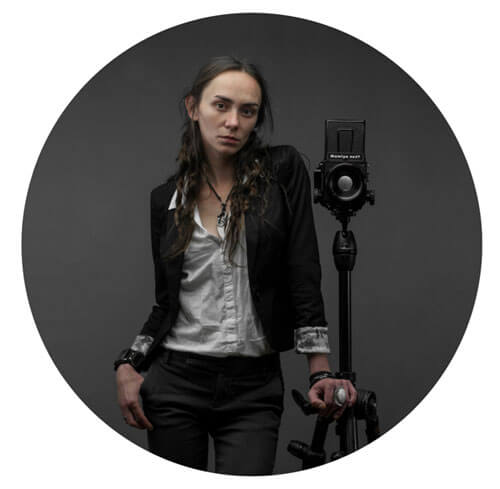Born in Poland in 1981, Justyna Neryng spent much of her childhood playing with her father’s cameras and dark room while roaming the forests of Chelmsko on the Czech boarder. As an adult, a mother and an immigrant to Britain, her photography has flourished into a substantial body of portraiture. Perhaps the most evocative of her works are her exquisitely emotive self-portraits that seem to carry the dark spirit of the forest from her childhood as well as potently baring the scares of modern womanhood. They show vulnerability and intimate eroticism as well as a deep sense of isolation and alienation. It is these portraits that have been most published and exhibited in both in her polish homeland and in the UK. More recently Justyna has begun to collaborate with her daughter Nell, on a project called Childhood Lost. Justyna currently produces her works in her adopted home town of Brighton and Hove, where she lives with her daughter.
Artist Statement:
Childhood Lost is an autobiographical ,self portrait in a different body, ongoing project exploring the nature of portraiture and memory. As a single mother I have found myself exploring notions and representations of childhood. I see my daughter’s experiences of growing up in urban England conflicting with my own experiences of growing up in rural Poland.
I must confess that my own childhood is not a source of many happy memories, perhaps the most resonant of which are the times I escaped to a world of fantasy played out in the forests surrounding my home village of Chelmsko. Watching my daughter grow up has in a sense held a mirror to my own memories of the past while experiencing her childhood dreams enacted through play, and story telling. I find myself in a strange place where I can experience my own memories as well as see my daughter’s childhood through my adult eyes. It is these notions I am seeking to explore with the Childhood Lost project. Interweaving childhood nostalgia with the stories and myths of my Polish childhood and those that I share with my essentially British daughter. The project is using these ideas to produce a series of portraits that evoke characters that populate this world we know as childhood. A court of characters from myth and dreams. The images are aesthetically inspired by portraiture from the Golden Age of Dutch painting. By drawing on paintings as inspiration I am hoping to give a timeless feel to the final images. Also key to the project is also the painstaking styling and prop building, which I am using to evoke these different persona played out by my daughter. I want to develop the series in to a substantial set of portraits of my daughter playing the characters of childhood, as well as producing more elaborate set pieces embracing a theatricality that would take the project to the next level. Subject to funding it would also be a dream of mine to be able to revisit the forests of my own childhood and produce work there.
Justyna Neryng is a multi-award winning self-taught photographer born in Poland and now living and working in the United Kingdom. She spent much of her childhood playing with her father’s cameras and dark room while roaming the forests of her hometown. She specialises in portraits and nudes, her photography has flourished into a substantial body of portraiture. She is mainly known for her enchanting theatrical portraits of her daughter, a gallery of triumphal characters, captured on a neutral and undefined background, with their fantastic ‘uniforms’ and imperious look . These images are aesthetically inspired by portraiture from the Golden Age of Dutch painting. And her exquisitely emotive self-portraits that seem to carry the dark spirit of the forest from her childhood as well as potently baring the scars of modern womanhood. They show vulnerability and intimate eroticism as well as deep sense of isolation and alienation.
Source: justynaneryng.com
